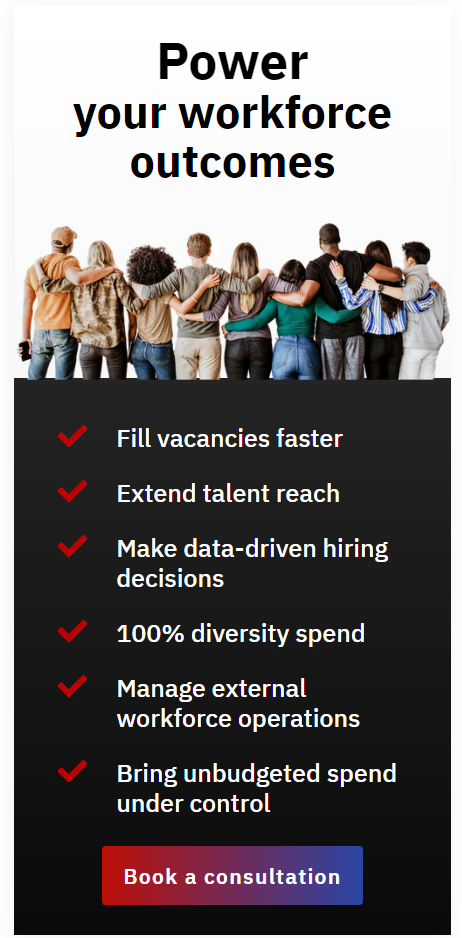How do you find a partner that can help your business to make the most of your flexible workforce opportunity? To harness a flexible workforce, you most likely will need a contingent workforce management partner. But what exactly should you look out for?
With so many different types of partnerships available to business and talent leaders, the choices can be overwhelming. In this article we offer some pointers on how to find the right one.
Origins of the Modern Flexible Workforce
Five years ago, you could bump into people in the office canteen and corridors and almost guarantee they were employees of the same business you work for. Not today.
Whether they are gig workers, self-employed freelancers, or contractors hired through an Employer of Record, many people today gain employment in what’s become known as the contingent (also called flexible) workforce.
The make-up of a modern workforce has changed. Today, temporary, contract, and gig workers are major contributors to the success of businesses. In most US companies, expect 1 in 3 workers to be employed by someone other than the company they deliver work for. This trend is catching on in Europe now too.
Why are Businesses Shifting to Contract Workers?
This seismic workforce transformation has been driven by business leaders who acknowledge their operations must be better able to be more flexible in response to market changes. The high costs and risks of employing people full-time are always in the backs of their minds too .
Flexible hiring has indirectly been further encouraged by COVID-19 that has forced many people to work from home. Its created a virtual work environment, which helped bosses realize that commuting to the office it’s not quite as essential as previously thought. Many knowledge workers aided by digital collaborative technologies such as online social office platforms (Slack, Teams, Ryver, etc.) and video-powered sharing systems (Zoom, Skype, Google Huddles etc.)—can get their work done in their kitchen, balancing their cat on their laps and feeding their child with an occasionally free hand, as easily as they can in an office.
The shift to home working has had a knock-on effect in the talent industry. Employers have seen a wider talent pool emerge from home working people who can’t realistically work 9-to-5 because of their other obligations but DO offer the skills and experience they need. And why not hire someone who works in a different country if nobody is going to the office anyway? What difference does geography make in the virtual world of work?
Governments have also played their role to enable this transition. They have encouraged a shift to use of contracted workers by failing to afford them the same protections when compared to their full-time brethren.
The Benefits of Hiring Contingent Workers
Here ’s a quick summary of the rewards of hiring contingent workers:
1. Fill talent needs faster
If you can’t find the perfect full-time employee, it’s likely you will be able to find similar skills in the contingent workforce.
2. Only pay for talent when you need it
You may pay slightly more per hour, but you only need to pay for contingent workers as and when you need them.
3. Tap into some of the world’s best talent
Many of the most talented professionals prefer to work as contractors because they can earn more income for their skills and experience. It also allows them to focus on what they’re good at.
4. Get expert and specialist advice
You don’t need some expert skills all of the time. For example, a company can only cope with so many big ideas. Hiring contractors is a good way to shape your workforce skills to best-fit needs.
5. Pay for results
It’s now possible to hire contractors on Statement-of-Work (SOW) contracts which means they get paid on results, not for the number of hours they work.

Why it Makes Sense to Work with a Different Partner to your Recruitment Agency
Hiring contingent workers is very different to hiring full-time employees. For a start, finding your talent is going to need a different blend of knowledge and technology. What’s more, many of the partners you will find in the market already have a large database of potential candidates with the expertise you need. These resources won’t be available to agencies that have traditionally specialized in the recruitment of full-time employees.
Also, spare a thought for the practical make-up of your partner provider. Contingent workforce partners are used to finding sort-term work opportunities and finding people. These agencies look after them as an employer or, if not, as a long-term agent (not so dissimilar to publishers or the agents that Hollywood stars rely on to find work).
Getting the Balance Right
No two contingent workforce management partners are the same, but there are general ‘types’ of partner that you can look out for. Which type is right for you will depend on what blend of people, process, technology and talent provision you need. Here are your options:
Contingent Workforce Management Consultant
Contingent Staffing Agency
These agencies perform the basic function of finding the flexible workers you need and hiring them out to you. They will bill you and take care of paying the contractor. Sometimes, these arrangements mean that they will act as an Employer of Record. Other times the contractor will be self-employed and the staffing firm will simply pass on what’s owed to the contractor once they’ve taken their fee. You need to check out precisely HOW the contractor is to be paid because
Basic contingent staffing agency
These agencies perform the basic function of finding the flexible workers you need and hiring them out to you. They will bill you and take care of paying the contractor. Sometimes, these arrangements mean that they will act as an Employer of Record. Other times the contractor will be self-employed and the staffing firm will simply pass on what’s owed to the contractor once they’ve taken their fee. You need to check out HOW the contractor is to be paid because there are potential legal implications if the contractor is working on your jobs on your premises and is misclassified with the tax authorities.
Employer-of-Record
Some businesses prefer to work with a dedicated agency that acts as an Employer-of-Record (EoR) for the people they want to hire. This doesn’t mean that you can’t have other staffing firms working with your EoR to find the people you need. The benefit of an Employer of Record is having a single point of contact to manage all of your contingent resources. This brings with it an additional layer of transparency and accountability that many employers want.
Master Vendor
Think of a Master Vendor as a ‘super-sized’ Employer-of-Record with lots of extra added tech and services to help support your flexible workforce sourcing and management. Often, they will supply their own technology platforms (so you don’t need to source one). Additionally, they will coordinate relations with other staffing agencies to deliver on your contingent workforce outcomes.
Managed Service Provider
If yours is a potentially large contingent workforce program and you know you’re going to need a large number of staffing partners to meet your needs—all operating on a level playing field—then you might want to consider a Managed Service Provider (MSP) like Workspend.
Talent Platforms and Hybrid Providers
Another option enabled by modern digital technology is a partner arrangement focused around a talent portal, where your talent is found and managed through a tech ecosystem. Depending on the provider, you may be required to manage the hiring and management activity directly or, in some cases, providers will offer a light-weight advisory and service support arrangement shaped around their technology.
Final Thoughts
Contingent working is not a new subject: there have been freelancers available to work since the middle-ages (the term comes from medieval knights who offered their lance to hire!). Today, the market is mature and, as we’ve covered, there are a host of available partnering options to help you achieve the best flexible workforce management solutions for your business.
Your choice of partner will determine to what extent you are able to respond to hiring manager requests to fill vacancies, and how painless this process will be. It makes sense to explore a number of options and seek references before you make your choice.
Looking for an expert contingent workforce management partner with a reliable track record of achieving ambitious client goals? Discover our partner program

Ian Tomlin
Author

